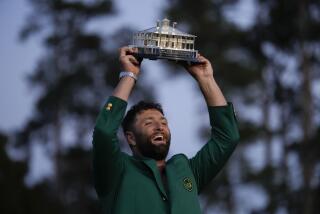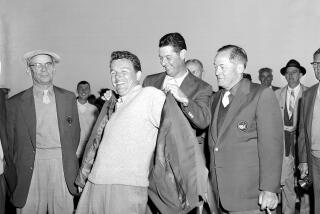Our Little Masters Has Become a Foreign Affair
AUGUSTA, Ga. â The Masters used to be a venerable American institution. As American as apple pie, the World Series, the old millstream. Hallowed ground. As much a part of our heritage as Shiloh, the first few bars of âDee-eye-ex-eye-ee!â You got all choked up thinking about it. It was ours. As much a part of our history as Tobacco Road, Godâs Little Acre. It was Jeeter Lesterâs Open.
It used to be won regularly by guys from Texas; Long Island; Latrobe, Pa.; Columbus; West Virginia. Guys named Hogan, Snead, Sarazen, Palmer, Nicklaus, Nelson, Watson.
Now look at it. Itâs about as American as apple strudel. Sauerkraut. Letâs have a few bars of âGod Save the Queen,â âDeutschland Uber Alles,â âGranada!â Never mind âYâall,â How about âAchtung!â They should move it to Dresden.
If they make a movie, it should be âThe Return of the Aliens.â Remake âA Foreign Affair.â The Visitorsâ Visa Open.
Do you realize this once uniquely American event has been won five of the last six times by a golfer from Europe? And seven of the last 10?
Do you know that only one foreigner won it the first 37 tournaments, but nine have won it the last 16 tournaments?
Whatâs going on here? Canât anybody play this damn thing without a monocle or a spiked helmet or a David Niven accent anymore? What happened to Texas, Georgia, the Carolinas? When did we start playing second fiddle to German marksmen, Spanish dons, British peers of the realm? Didnât we used to beat the likes of these four-a-side? If they were in the tournament other years, we didnât even know about it. You think Nicklaus ever held up play to find out how some guy from Stuttgart or Santander or Wales was doing? No, he wanted to know what Arnold was doing. Fuzzy.
It all began innocently enough. The Masters was conceived and established by Bobby Jones as a kind of conclave of friends, gentlemen golfers, largely amateurs but with a few selected professionals. Bobby, of course, never became a professional (ugh!) himself and he visualized his tournament as a continuation of the kind of golf played in his era when the amateur game was on a par with the pros and the U.S. Amateur (and the British) was at least as important a tournament as the Greater Greensboro Open. Bobbyâs tournament was as exclusive as a cotillion. Itâs a wonder they didnât play in tuxes.
They more or less coined the term invitational . And the earliest fields leaned heavily on those who didnât make a living out of the game but played instead for tea trays, loving cups and assorted silverware and wall plaques. The Walker Cup team, a collection, usually, of stockbrokers, bankers and Park Avenue doctors and lawyers who played an international (amateur) match against the Brits, were an integral part of the field.
Only the flower of professional golf got invited--the winners of such socially correct events as the U.S. Open, the British Open and their amateur counterparts. (Winners of the PGA were grudgingly accepted, but got fewer years in their exemptions). And they had to wipe their feet.
Remember, golf was hardly a way to get rich in those days. Byron Nelson won 19 tournaments in 1945 and was leading money-winner with $63,335. Today, you get more than that for finishing fourth at the Doral. Hogan won 10 tournaments in 1948, including the U.S. Open and the PGA, and got $32,112 for the year.
The Masters was the first to pioneer inviting key international players. These were selected arbitrarily by Jones and his partner, Clifford Roberts, and they were not a significant factor till 1961, when the first foreigner, South Africaâs Gary Player, won the tournament.
The Masters began to creep out of its category as kind of golfâs version of the House of Lords when sportswriters on their way north from baseballâs spring training in Florida made a practice of stopping off at Augusta to report on Robert Tyre Jones Esq.âs little gentlemen-only soiree.
The Masters became a âmajor.â No one is quite sure how. Or why. It was not a difficult tournament to win. Only about eight golfers annually had the game to win anything but a four-ball at Wykagyl or Shinnecock. Half the players in the field were 2-handicappers who sold bonds for a living.
When Player won, it had an unsettling effect on the game. For one thing, television was beginning to poke its nose in, and some people--our hero here included--began to wonder about the propriety of inviting a foreign player to come in otherwise unqualified when some American players, to wit, African-Americans, could not manage to get invited.
The Masters replied hotly that they could get in. Just finish 16th or better in the U.S. Open or eighth or better in the PGA.
Foreign players, of course, had to fit none of these qualifications and this was so patently unfair that, in the mid-1970s, the Masters relented and agreed to invite any player who won a tour tournament or finished in the top 30 on the preceding yearâs money list.
This broke the color barrier, but by 1978 when Player won again, it was the foreign invaders taking over the Masters.
That year, a little-known Spanish kid with the unwieldy name of Severiano Ballesteros was in the pack and his daring game loved the wide-open fairways and landing-strip greens of Augusta National. He finished ninth. But within two years he was winning. And the floodgates opened. He won again in â83. He was second in â85 and in a playoff in â87. And the Europeans, who spurned the rest of our tour, began to fall all over themselves to get invited to Augusta.
German Bernhard Langer was to win in â85 and again last year. Britainâs Sandy Lyle won in â88. Nick Faldo won in â89 and â90, and Ian Woosnam won in 1991. And whom did he beat out? Not Lanny or Hale or Ben or Payne or Curtis, but Jose Maria Olazabal, no less.
The poet has said, âThere is some corner of a foreign field that is forever England,â and while he may have been thinking of Flanders, it could apply to Augusta.
Why do these tourists make the Masters their own? What is it about that little corner of the world that is forever England? The course record, 63, is held by Nick Price, a Zimbabwean. It was Brit Nick Faldo who sank the longest putt in Masters history, a 100-footer on the second hole in 1989. Seve Ballesteros holds the record for birdies, 23 and one eagle, set in 1980 and Seve is also the youngest ever to win the Masters, at 23, and also the youngest ever to participate, at 20.
Itâs true you canât pick the winner of a golf tournament. But you can pick his part of the world in the Masters. He may not actually wear a monocle, but you can make a case he will have a hyphen in his name or call the subway the âchubesâ (as in a âchubeâ of toothpaste) or pronounce âscheduleâ as âshed-yool.â Or he will sound like Baron Munchausen or call you âMite.â He will probably have no idea at all who Barry Bonds is or what team Barry Switzer coaches. But heâll go around making these 100-foot putts and calling a three-wood a âspoonâ and wonder why the tournament doesnât break for tea every day the way they do at a proper tournament at the Royal Something-or-Other course off the North Sea.
Where are the Hogans and the Sneads and the Nicklauses and the Palmers when we need them? Why did Bobby Jones do this to us? The only Arnold this fits is Benedict.
More to Read
Go beyond the scoreboard
Get the latest on L.A.'s teams in the daily Sports Report newsletter.
You may occasionally receive promotional content from the Los Angeles Times.










